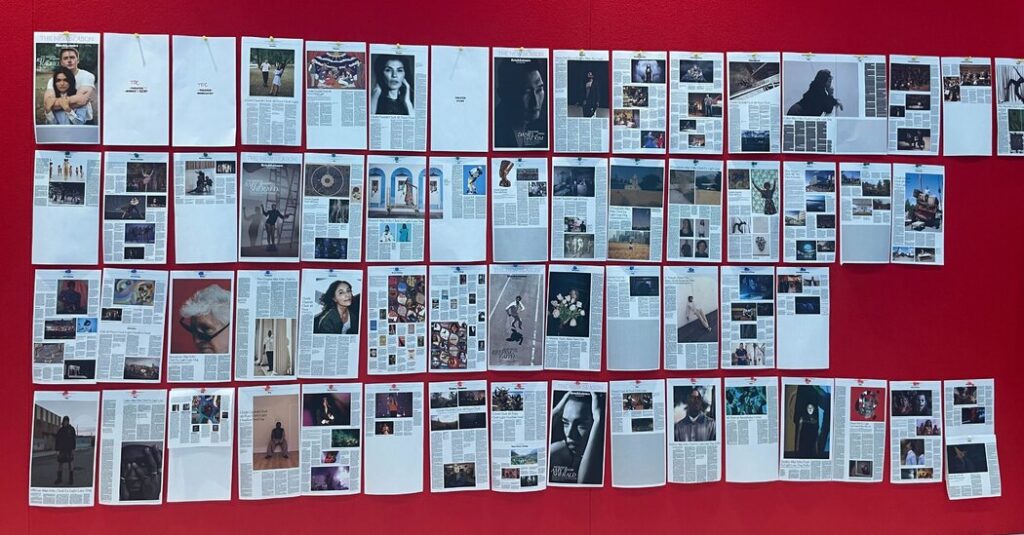Times Insider explains who we are and what we do, and delivers behind-the-scenes insights into how our journalism comes together.
In the spring, Andrew LaVallee starts planning for fall.
As the editor of The New York Times’s Arts & Leisure section, he is constantly considering the cool, crisp season, when Broadway stages new performances, galleries open much-anticipated exhibitions and new TV series are released on streaming services, all shaping cultural conversation and impassioned debate.
Months of planning culminate in the Arts & Leisure fall preview, an annual section that shares with readers the can’t-miss cultural works of the season.
This year’s section, which appears in print on Sunday, includes the work of about 70 journalists. Across 92 pages, 45 articles, five covers and 11 art forms, including theater, film, dance, podcasts, books and video games, The Times shares the best of what fall has to offer.
Planning begins in earnest in April. But for LaVallee, the content is “on my mind all year round.”
“Really early in the year, or even the year before, you’re starting to hear about, say, Robert Downey Jr. is going to be in his first Broadway show in the fall,” LaVallee added. “I’m starting to bookmark things like that in my brain.”
In this year’s preview, there’s an article on a Broadway revival of “Romeo and Juliet,” a discussion with the filmmaker Pedro Almodóvar and a piece on the actor Daniel Dae Kim and his long-anticipated return to the stage.
Readers will also find music critics’ picks from pop (Chappell Roan) to classical (Wagner’s “Ring” cycle) to rap (Sexyy Red). There’s a panoply of exciting upcoming releases to write about, too, including art exhibitions, TV shows, even video games. (In the new Legend of Zelda, Princess Zelda is finally a playable protagonist.)
There are reviews and roundups aplenty, but longer pieces put buzzy works into larger cultural conversations. In an article on Demi Moore and body politics, for example, The Times’s chief film critic Manohla Dargis asks readers to consider Moore’s career, and her history of baring it all onscreen, in a wider context.
When LaVallee and a handful of editors first sat down to brainstorm the behemoth of a section, they wondered: What movies would invite debate? Which plays would draw the biggest crowds? Would any new TV series keep viewers glued to their screens?
So begins the mapping of the plans, which, of course, change along the way.
“There’s plenty of heartbreak,” LaVallee said. “Things just inevitably don’t work out. And so you’re always going to regroup.”
And then there is the massive art effort. The editors commissioned 19 photographers, and five illustrators, for the project. They pored over roughly 2,389 images, including photographs from the shoots, archival works and publicity stills. (Just south of 200 made the final cut in print.)
“The first thing we want is variety,” said the photo editor Jolie Ruben. She also wanted to ensure that a photo “could work with a certain crop and type on it, and be a strong enough image” to engage a reader.
They wanted the images to be artistic, but subjects in “cover” photos needed to be easily identifiable. Amanda Webster, a photo editor, pointed to the pictures of the actress Margaret Qualley, one of the five “cover” stories, as examples.
“There are some, where the photographer was playing with projections and Margaret was moving and they were a little bit more abstract, that are so beautiful,” Webster said. But the image the team selected was simple, arresting: A moody shot of Qualley looking off camera.
“We really put a lot of time and effort into our photography,” added Jennifer Ledbury, the section’s art director. “We try to let those have as much play as we can.” In July and August, Ledbury and Felicia Vasquez, another editor, began to think in earnest about how to display articles and images in relation to one another.
Despite months of prep work, the final days before the section goes to press are always stressful. Copy comes in just under deadline; photos need last-minute toning. Hours are spent fine-tuning the layouts and typeface arrangements. Then, at the push of a proverbial button, the pages are sent to the printing plant to be brought to life.
LaVallee said he felt confident the team had chosen a diverse range of voices to feature in the preview, offering readers a window into culture across the globe.
“I really tried to make it something that all different kinds of readers can find something interesting in,” he said. “Stories that appeal to people who are New Yorkers and people who are elsewhere in the country, in the world, readers of all different ages and types.”
He hopes Times readers can slip into the section this Sunday, that the content helps them escape into another world — or, reconsider something about the one they already reside in.


